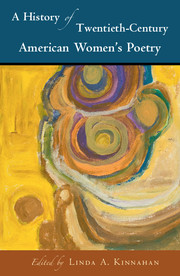Book contents
- Frontmatter
- Contents
- List of figures
- List of contributors
- Preface
- Acknowledgments
- PART I MAPPINGS AND CHRONOLOGIES
- PART II ETHNICITY, RACE, AND IDENTITY
- PART III MATERIAL FORMATIONS
- PART IV LINEAGES, TIES, AND CONNECTIONS
- PART V FORM, LANGUAGE, AND TEXT
- PART VI CODA
- 23 Post-Millennial Women's Poetry
- Bibliography
- Index
23 - Post-Millennial Women's Poetry
from PART VI - CODA
Published online by Cambridge University Press: 05 June 2016
- Frontmatter
- Contents
- List of figures
- List of contributors
- Preface
- Acknowledgments
- PART I MAPPINGS AND CHRONOLOGIES
- PART II ETHNICITY, RACE, AND IDENTITY
- PART III MATERIAL FORMATIONS
- PART IV LINEAGES, TIES, AND CONNECTIONS
- PART V FORM, LANGUAGE, AND TEXT
- PART VI CODA
- 23 Post-Millennial Women's Poetry
- Bibliography
- Index
Summary
Mapping the terrain of contemporary American poetry and poetics presents real challenges. One factor is sheer magnitude: new presses and journals are founded every year, as well as blogs, listservs, and websites devoted to poetry. As Craig Dworkin enumerates in The Consequence of Innovation: 21st Century Poetics, “the publication of poetry increased steadily and exponentially – year by year – over the course of the twentieth century, and that trend continues, unchecked, into the new millennium” (7–8). While large commercial presses such as Random House and Beacon are publishing less poetry, new technologies such as print-on-demand have made it financially possible for new presses and “webzines” to emerge each year. In addition, there is little consensus among academics, scholars, critics, and poets about which work is worth reading. As Dworkin notes, “works that leading scholars of poetry would hold to be key canonical texts might not even qualify as ‘poetry’ for others” (12). While the history of poetry in the second half of the twentieth century was typically defined through movements and schools like the New York School, New Formalism, the Black Mountain School, and Language Poetry, beginning in the 1990s, poetic schools and movements became much more plastic and unbounded.
Combined with the ever-expanding numbers of small presses and publishing poets, this lack of consensus has also made it increasingly difficult to categorize poetic styles “in terms of schools or regions or first principles.” Perhaps this has always been true, but the difficulty has been compounded by the apparent dismantling of familiar rubrics for distinguishing one style or school from another, and in particular the breakdown of rigid dichotomies between poetic traditions: distinctions between “the raw” and “the cooked,” “open” and “closed,” “experimental” and “expressive,” “innovative” and “traditional,” “mainstream” and “avant-garde” have been questioned and problematized on many fronts. By the late 1990s, “traditional points of orientation and affinity [had] eroded dramatically.” What constituted the mainstream was no longer clear as poets from across the spectrum of contemporary poetry engaged techniques of fragmentation, disjunction, and appropriation, explicitly or implicitly connecting their poetic practice to materialist and poststructuralist theories of language and subjectivity.
For some this shift produced yet a new category of poetry, one that draws equally on experimental, Modernist techniques and on lyric expressiveness. The publication of Fence magazine in 1997 is considered one landmark of this new trend.
- Type
- Chapter
- Information
- A History of Twentieth-Century American Women's Poetry , pp. 377 - 392Publisher: Cambridge University PressPrint publication year: 2016



